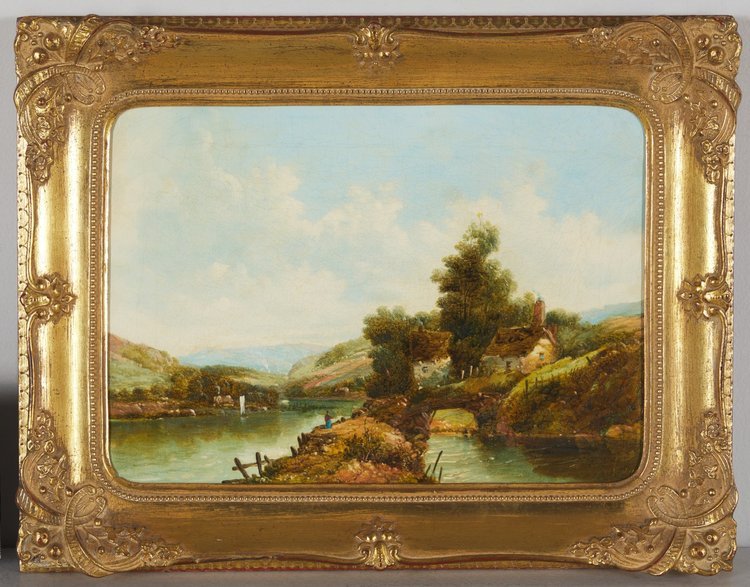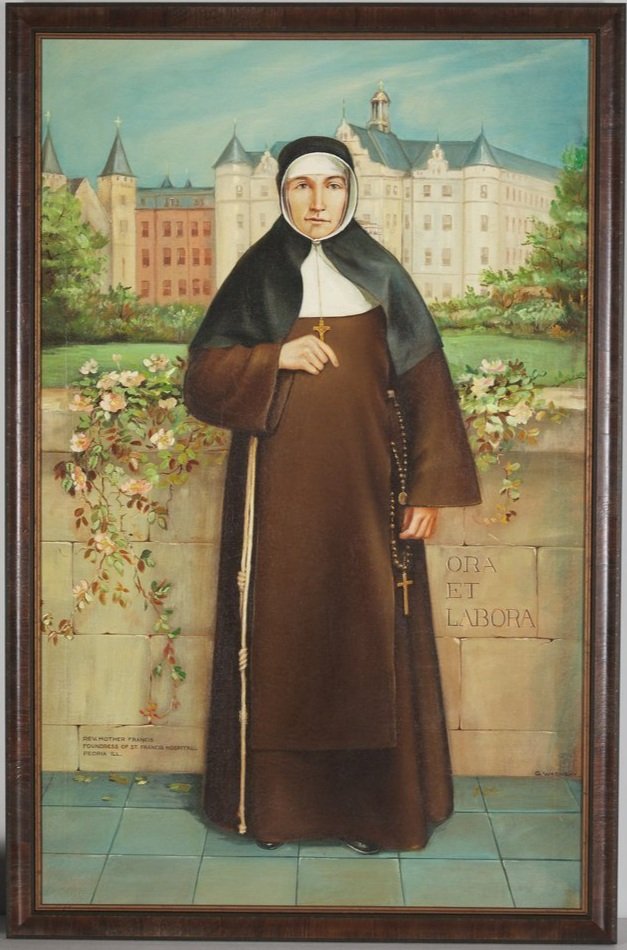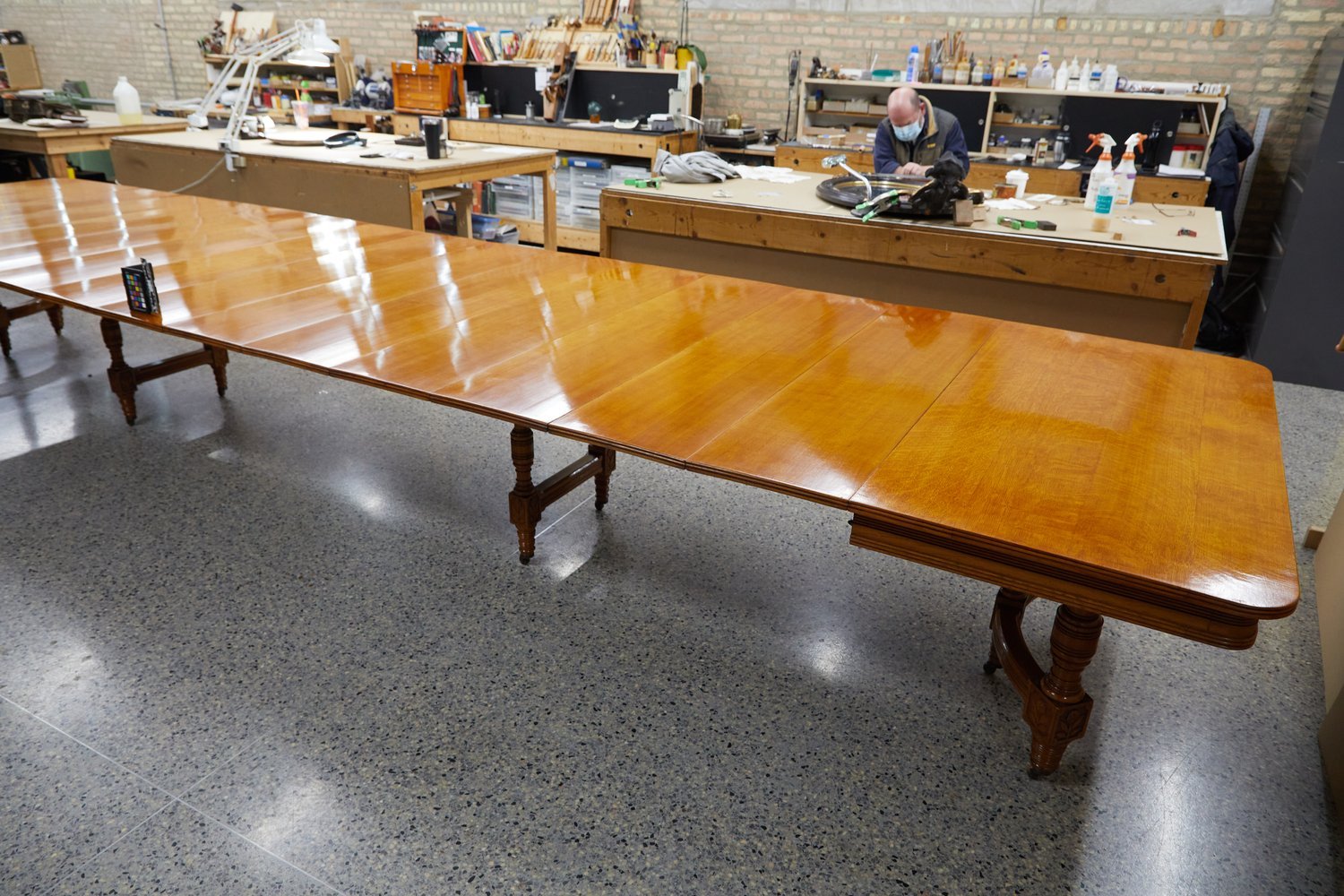Patrick Henry O'Brien was born in Laurium, Michigan, on March 15, 1868. His parents, Mary and Patrick, were immigrants from County Cork, Ireland, who settled in the Keweenaw Peninsula, Michigan, in 1863. The area was known as Copper County for the prevalent copper mining from the 1850s through the 1960s. Patrick lost both his father and uncle to mining accidents, leading him down a very different path.
"Serve with the Greatest Care and Love" Conserving a painting of Mother M. Frances Krasse
Mother M. Frances Krasse left behind a legacy when she passed away from tuberculosis at the age of 46 in 1885. An emigrant from Germany, Mother M. Frances only spent nine years in Illinois. Along with five other Sisters, she arrived in Peoria in 1876 to start a hospital they named called St. Francis Hospital and was appointed the local superior. The following year, they formed a new congregation - Sister of the Third Order of St. Francis of Peoria, with Mother M. Frances serving as the first Mother General.
A Community Comes Together: The Fisher Foundation Project Part 2
In 2014, a small group of volunteers in Marshalltown, Iowa, met to discuss the restoration of the Fisher Community Center Art collection, which had been untouched since the 1960s. The artworks were in desperate need for repair, care, and cataloguing, so the group set to work filing for grants and hiring specialists to help.
A Letter from Heather Becker, CEO of The Conservation Center
The Conservation Center CEO, Heather Becker, shares an update on the state of the company and staff since the start of the COVID pandemic in March 2020.
I sent out a letter in March 2020 at the beginning of the pandemic, and then I sent an update in September 2020, which ended with "so stay tuned."
As many of you know, we have been writing and sending out monthly newsletters for the last 15 years, and a great number of you are loyal readers. So, thank you for "staying tuned," whether over the last 2 or 15 years, as our community of 30,000+ readers has grown.
Treating a Delicate Textile
Samplers are a type of embroidery traditionally used to showcase a person's needlework skills. During the 17th and 18th centuries, samplers became increasingly popular. They were common among young girls as a way to learn needlework and teach different stitching techniques. Samplers were also used as a way to record family history, often given as gifts or hung on the wall as a decorative item.
Portrait Photograph with a Layered Frame
Even when they may seem simple, almost every treatment carried out in The Center's laboratory is a collaborative effort between different conservations and departments. This photograph, "Portrait of George Ramige" is a family antique and arrived in stable condition but with age-related issues. A reinforced photograph housed in an antique frame, this artwork was treated in three of our departments; Works of Art on Paper, Furniture, and Custom Framing and Display.
The Art of Accessories: A hand-braided hairwork necklace
This hairwork necklace is circa 1845 and is part of the Arkansas Museum of Fine Arts collection in Little Rock, Arkansas. Constructed of braided hair and gold, it arrived at The Center displayed on a fabric-lined mount. The metal components exhibited minimal grime and oxidation, with solder marks on the two clasps that hold the chained cross at the top and the proper right end of the cross. Tears and fraying hair were noted on fourteen braided orbs; the damage varied, including missing material and deformations. The gold cap on the bottom of the cross was also missing. But, the focus of this treatment would be the hairwork beads and cross.
Marooned: A student's homage to his mentor
The Brandywine School of Artists was a group of impressionist and post-impressionist painters who lived and worked in the Brandywine River Valley region, primarily in Delaware and Pennsylvania, from 1870 to 1920. The artists are best known for depicting people residing along the Brandywine River during the late 19th century.
Philadelphia artist Howard Pyle founded the group. He had been a successful illustrator for books and magazines, but he wanted to teach his students more about color, light, form, space, and composition. He started teaching at Drexel Institute in 1885 before founding the Howard Pyle School of Illustration Art. His artistic style influenced many artists, such as N.C. Wyeth, Thornton Oakley, and Frank Schoonover.
Digital Duplicates: Reviving through Reproduction
Digitalization is a relatively new way of preserving heritage. Whether family heirlooms or documents of cultural significance, digitizing allows us to keep history safe and share it with others as facsimiles or electronic images. While some items can be safely digitized at home, here at The Center we often see items of extreme delicacy, brittleness, or constructed in such a way that makes do-it-yourself scanning a risky prospect.
Dinner for 30? Treating a 13 Leaf Dining Table
Families still come together for dinner, but how many are hosting dinner parties? Many households may have seating for two, four, or maybe 8, but these days not many have seating for 30. For affluent families at the turn of the 20th century, the ability to host large dinner parties was a mark of wealth and social standing - a display of opulence. Tables were deliberately designed wider than we see today, as speaking to guests across the table was considered bad manners. And dining room tables also had many leaves to adjust to the perfect length to accommodate that evening's guests.
Part 1: Reviving The Assumption of Mary
The Assumption of Mary is a stunning and powerful image. It is a depiction of the event that gives the picture its name: the assumption of Mary into heaven. At nine feet tall, the commanding size creates a powerful experience that draws in the viewer. It's a captivating work of art, full of movement and life. But years of grime, discolored varnish, and mismatched repaint detracted from the painting.
What Does it Mean? Defining Conservation Terms
Talking about Revolution: Treating a 1740 War Drum
The power of the drum is rooted in its ability to send messages. With the constant tempo of warriors' feet beating on the ground, it summons allies and beats back enemies with the same force. It can be used as an instrument of war or peace, a companion to dance and celebration. During the Revolutionary War, the drum played a vital role in conveying messages, persuading troops to fight, and boosting morale.
Uncovering True Colors: Conserving The Stations of the Cross
Founded in 1837 in Davenport, Iowa, St. Anthony Catholic Church is the second oldest Catholic church west of the Mississippi River. The historic church has evolved over the years, from a small 3-room building shared with the local judicial court and town hall, to merging with neighboring parish St. Mary's Catholic Church in July 2020. As a result of the merger, St. Anthony's has two sets of the Stations of the Cross; one, plaster relief sculptures set in the walls of the church, and the second, large oil paintings from St. Mary's. As John Cooper, Pastoral Associate at St. Anthony Catholic Church shares, "Both sets in their own unique ways, accomplish the artistic purpose of pulling you into the scene with Christ."
Far from Common: The Commonplace Book of Louis de Marillac
Each commonplace book is unique. They are collections of notes, proverbs, ideas, adages, poems, prayers, recipes, and facts. Commonplace books were created to document knowledge from other sources that were important or useful to the reader. The Commonplace Book of Louis de Marillac is part of the Vincentian Studies Collection of DePaul Univerisity, Chicago. Louis de Marillac (1556-1604) was a member of the French aristocracy and the legal guardian of St. Louise de Marillac, who cofounded the Daughters of Charity with St. Vincent DePaul.
A Treasurer Trove of History
Whether you are a history lover, a genealogy buff, or a family storyteller, family documents can be a treasure trove of information. Family documents are sources of valuable knowledge that help paint a picture of your ancestors and the world in which they lived. By storing family documents properly and preserving them for future generations, we can keep these stories alive for generations to come.
Tick Tock! The before and afters of an Intricate 1790s English Clock
Still in its crate, the beauty and intricacy of this 18th-century clock are unmistakable. The clock's many components, from the clockworks to the music box mechanics, the woodworking, and delicately painted metal panels, showcase the craftsman that brought this piece to life in late 18th century England. And now, in the 21st century, a new team of skilled professionals came together to restore this clock's original integrity.
Astounding Science (non) Fiction! Conserving a Pulp Fiction Painting
Astounding Stories was an American science fiction magazine that began in 1930 when Clayton Publishing launched it to capitalize on the interest in science fiction stories. In the 1930s, it became one of the most popular and influential magazines in the science fiction world; in 1934, it had double the circulation of its science-fiction rivals. While the magazine's title has changed over the years, in 2011, it became the longest-running, continuously published magazine dedicated to the science fiction genre. In fact, the magazine is included in the library of the International Space Station.
Preparing for Display: Conserving Treasures for the Snite Museum at the University of Notre Dame, Madonna and Child with Saints
As construction continues on the University of Notre Dame's new art museum, the conservation of select paintings from the Snite Museum of Art continues in The Center's laboratory. Scheduled for completion in late-2023, the new Raclin Murphy Museum of Art will increase the University's capacity to display its art collection and accept programs that the current facility, the Snite Museum of Art, cannot because of size restrictions. The Painting Conservation Department and Custom Framing and Fabrications departments recently completed treatment of the 15-century painting Madonna and Child with Saints.





















